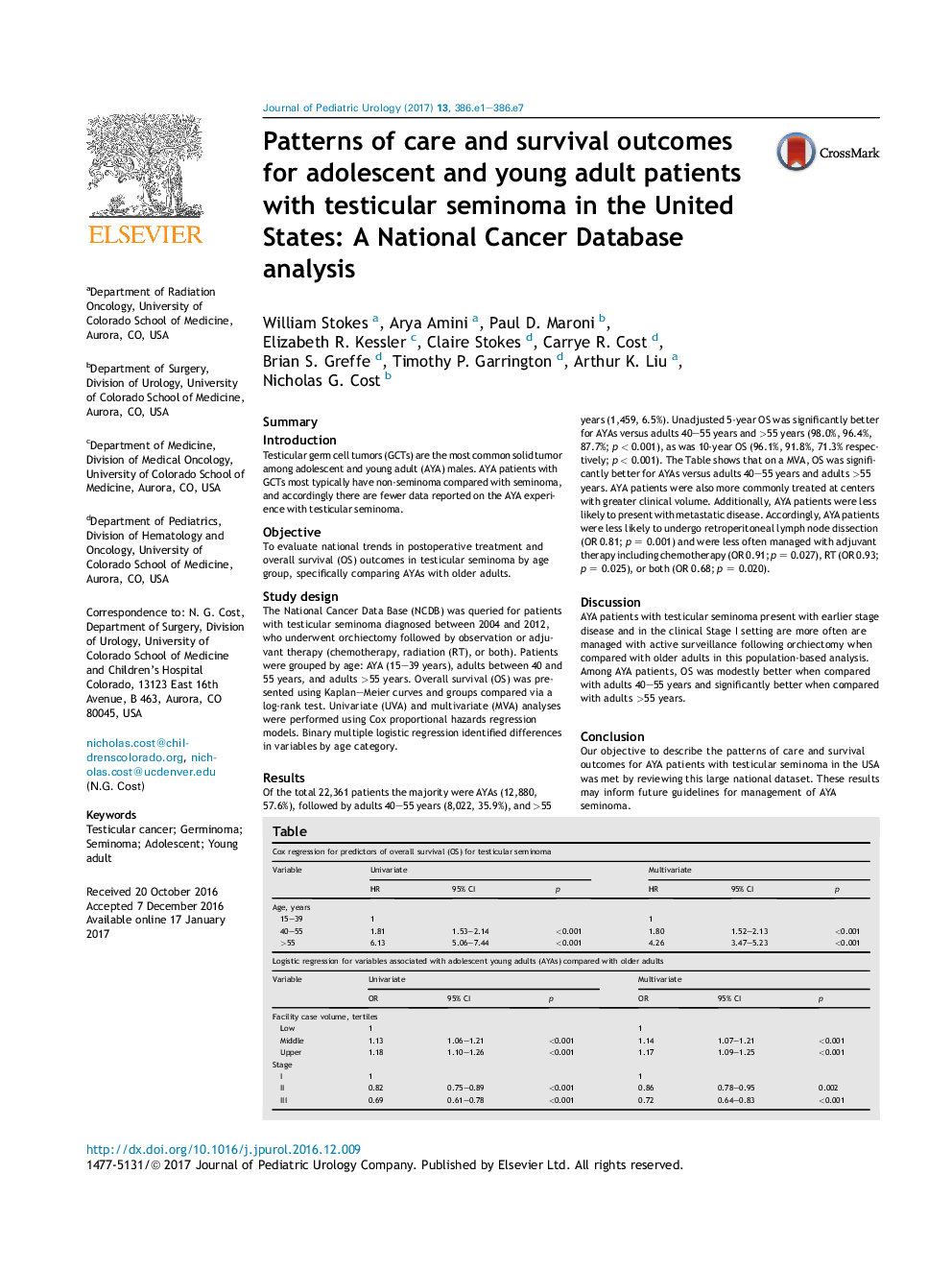| Article ID | Journal | Published Year | Pages | File Type |
|---|---|---|---|---|
| 5718554 | Journal of Pediatric Urology | 2017 | 7 Pages |
SummaryIntroductionTesticular germ cell tumors (GCTs) are the most common solid tumor among adolescent and young adult (AYA) males. AYA patients with GCTs most typically have non-seminoma compared with seminoma, and accordingly there are fewer data reported on the AYA experience with testicular seminoma.ObjectiveTo evaluate national trends in postoperative treatment and overall survival (OS) outcomes in testicular seminoma by age group, specifically comparing AYAs with older adults.Study designThe National Cancer Data Base (NCDB) was queried for patients with testicular seminoma diagnosed between 2004 and 2012, who underwent orchiectomy followed by observation or adjuvant therapy (chemotherapy, radiation (RT), or both). Patients were grouped by age: AYA (15-39 years), adults between 40 and 55 years, and adults >55 years. Overall survival (OS) was presented using Kaplan-Meier curves and groups compared via a log-rank test. Univariate (UVA) and multivariate (MVA) analyses were performed using Cox proportional hazards regression models. Binary multiple logistic regression identified differences in variables by age category.ResultsOf the total 22,361 patients the majority were AYAs (12,880, 57.6%), followed by adults 40-55 years (8,022, 35.9%), and >55 years (1,459, 6.5%). Unadjusted 5-year OS was significantly better for AYAs versus adults 40-55 years and >55 years (98.0%, 96.4%, 87.7%; p < 0.001), as was 10-year OS (96.1%, 91.8%, 71.3% respectively; p < 0.001). The Table shows that on a MVA, OS was significantly better for AYAs versus adults 40-55 years and adults >55 years. AYA patients were also more commonly treated at centers with greater clinical volume. Additionally, AYA patients were less likely to present with metastatic disease. Accordingly, AYA patients were less likely to undergo retroperitoneal lymph node dissection (OR 0.81; p = 0.001) and were less often managed with adjuvant therapy including chemotherapy (OR 0.91; p = 0.027), RT (OR 0.93; p = 0.025), or both (OR 0.68; p = 0.020).DiscussionAYA patients with testicular seminoma present with earlier stage disease and in the clinical Stage I setting are more often are managed with active surveillance following orchiectomy when compared with older adults in this population-based analysis. Among AYA patients, OS was modestly better when compared with adults 40-55 years and significantly better when compared with adults >55 years.ConclusionOur objective to describe the patterns of care and survival outcomes for AYA patients with testicular seminoma in the USA was met by reviewing this large national dataset. These results may inform future guidelines for management of AYA seminoma. Table. Cox regression for predictors of overall survival (OS) for testicular seminomaVariableUnivariateMultivariateHR95% CIpHR95% CIpAge, years 15-3911 40-551.811.53-2.14<0.0011.801.52-2.13<0.001 >556.135.06-7.44<0.0014.263.47-5.23<0.001Logistic regression for variables associated with adolescent young adults (AYAs) compared with older adultsVariableUnivariateMultivariateOR95% CIpOR95% CIpFacility case volume, tertiles Low11 Middle1.131.06-1.21<0.0011.141.07-1.21<0.001 Upper1.181.10-1.26<0.0011.171.09-1.25<0.001Stage I11 II0.820.75-0.89<0.0010.860.78-0.950.002 III0.690.61-0.78<0.0010.720.64-0.83<0.001
